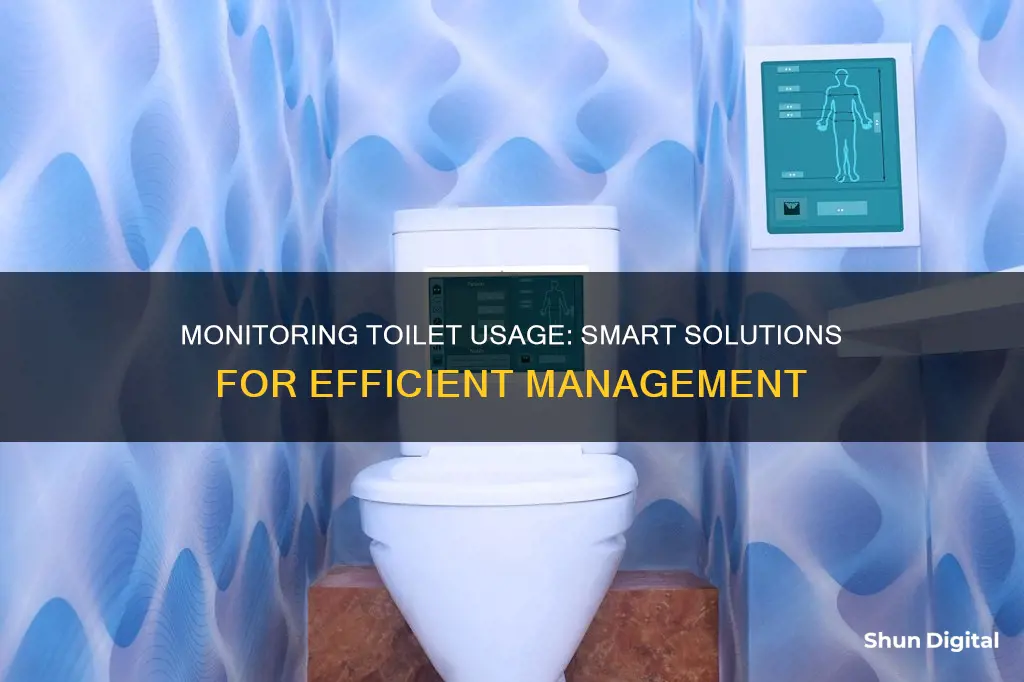
Toilet usage is an important topic, especially when it comes to water conservation and leak detection. There are various devices available on the market that can help monitor toilet usage, such as the LeakAlertor 6000, Pani Smart Water Monitor, and SI-Flush Sensors. These devices can be easily installed and provide real-time data on water usage, helping to identify leaks and reduce water waste. With an average of 20% of toilets leaking, monitoring toilet usage can lead to significant water and cost savings. Some devices also offer features like leak alerts and water conservation tips. Additionally, smart water sensors can be used to track overall home water usage, providing insights into water-using appliances and helping to create water budgets.
| Characteristics | Values |
|---|---|
| Purpose | Detect leaks, monitor water usage, notify user |
| Installation | Easy, no tools required, no special set-up necessary, no plumber needed |
| Placement | Between the supply line and fill valve on any toilet |
| Power Source | Battery |
| Alerts | Visual, audible, text message |
| Data | Real-time, minute-to-minute, day-to-day |
What You'll Learn

Toilet leak detection devices
LeakAlertor 6000 Toilet Leak Detector
This device installs in seconds and requires no tools or special setup. It detects leaks, running toilets, and other problems that cause high water bills. The LeakAlertor alerts you with visual and audible alerts and works with tank-based toilets. It has a three-year warranty and is powered by a lithium metal battery, which is included with the device. The LeakAlertor has received positive reviews for its performance, ease of installation, and value, although some users have noted issues with sound quality and battery life.
Toilet Leak Detection Tablets
These tablets are an easy and inexpensive way to detect silent leaks in your toilet. Simply drop a tablet into the toilet tank, and if there is a leak, the coloured dye will appear in the toilet bowl. This method is simple and effective, allowing you to identify leaks early on.
Smart Water Sensors
Smart water sensors, such as the Govee WiFi Water Sensor, can be placed near your toilet or in other areas of your home that are prone to water leaks. These sensors connect to your smartphone via Wi-Fi and will send you alerts if they detect any water leaks. Some sensors also have adjustable alarms and can be purchased in packs of two or more for whole-home coverage.
Water Block Automatic Toilet Leak Detector & Shutoff Valve Kit
This device not only detects leaks but also automatically shuts off the water flow to prevent floods and property damage. It includes fittings for easy installation and is a great way to protect your home from water damage and conserve water.
Flume Water-Meter Sensor
The Flume water-meter sensor is a Wi-Fi-enabled device that attaches to your home's water meter and provides real-time water usage data. It helps you track water usage, detect leaks, and create a water budget via a smartphone app. The Flume app provides minute-to-minute data and helps identify leaks by showing you how much water is being used and where. This device typically costs around $249, but some water departments offer it at a discounted price as part of water conservation programs.
Monitoring App Usage: Android's Built-in Tools for Control
You may want to see also

Monitoring water usage to identify leaks
Monitoring water usage is a great way to identify leaks and reduce water wastage. Here are some ways to monitor water usage and identify leaks:
Smart Water Sensors
Smart water sensors like the LeakAlertor 6000 can be attached to your toilet to detect leaks, running toilets, and other problems. These sensors are easy to install and provide visual and audible alerts to notify you of any issues. They can also help identify faulty parts, allowing you to take prompt action to fix the problem.
Manual Checks
You can also manually check for leaks by following these steps:
- Remove the toilet tank lid: Place one hand on each side of the lid and carefully lift it off, placing it on the floor nearby.
- Check the water level in the tank: Look for a marked "water line" on the side or back interior wall of the toilet. If the water level is above or below this line, adjust the fill valve to ensure the correct water level.
- Conduct the food colouring test: Add 15-20 drops of food colouring to the water in the tank and wait for about 30 minutes.
- Check the water in the bowl: If the coloured water appears in the bowl, there is a leak at the flapper or a crack in the overflow tube.
- Repeat for all toilets: If you have multiple toilets, perform the same test on each to identify if the issue is specific to one toilet or more.
Monitor Water Bills
Keep an eye on your water bills. A sudden increase in your water bill could indicate a leak or excessive water usage. Compare your recent bills to identify any unusual spikes in water usage.
Listen for Unusual Sounds
Pay attention to any unusual sounds coming from your toilet, such as a hissing noise, which could indicate that the fill valve is not shutting off properly when the tank is full.
By combining these methods, you can effectively monitor water usage and quickly identify any leaks, preventing water wastage and reducing your water bills.
Monitoring Individual Process Internet Usage: A Comprehensive Guide
You may want to see also

Using technology to monitor usage
The use of technology to monitor toilet usage is an emerging concept that has been explored by researchers and companies alike. This technology takes the form of "smart toilets" that can be fitted with various gadgets to monitor the health of the user.
One such example is a "smart toilet" developed at Stanford University, which can detect a range of disease markers in stool and urine, including those of some cancers, such as colorectal or urologic cancers. The toilet is fitted with motion sensors and a suite of technologies that use motion sensing to deploy a mixture of tests that assess the health of any deposits. Urine samples undergo physical and molecular analysis, while stool assessment is based on physical characteristics. The data is then sent to a secure, cloud-based system.
Another example is a smart toilet developed by Duke University, which uses artificial intelligence to analyse patients' stool and give gastroenterologists information to provide appropriate treatment for chronic issues such as inflammatory bowel disease (IBD) and irritable bowel syndrome (IBS). The toilet takes an image of the stool within the pipes after a person has a bowel movement and flushes, and the data collected over time provides insights on the patient's stool form and the presence of blood.
Other companies such as Panasonic and Toto have also developed smart toilets that can test urine and track body fat, detect health problems and conditions such as stress, and make lifestyle suggestions.
While the use of smart toilets has the potential to revolutionise healthcare and provide valuable insights into an individual's health, there are also concerns surrounding user privacy and data security. The data collected by these toilets could provide insights into a person's risk of disease, diet, exercise level, drug use, and mental health, among other things. As such, it is important to establish an ethical framework for the use of smart toilets and ensure that data is kept secure and protected.
Monitoring Data Usage on iPhone 5: Verizon Guide
You may want to see also

Analysing water usage patterns
For example, the Pani Smart Water Monitor can be installed on shower heads, toilets, and other fixtures to help you understand your household water footprint. It can also be used to monitor elderly bathroom activity, such as shower hygiene and toilet-flush tracking for medical reasons. The LeakAlertor 6000 Toilet Leak Detector is another device that can be installed in seconds and helps detect leaks, running toilets, and other problems.
If you're looking for a more DIY approach, you can try using a system like ESP32, which involves using microphones and firmware to notify you if water is running for too long.
By monitoring your water usage patterns, you can identify areas where you can conserve water and reduce your water bills. Additionally, these devices can help you detect leaks early on, preventing water damage and costly repairs.
Monitoring Electrical Usage: Circuit Surveillance Simplified
You may want to see also

Reducing water wastage
Water wastage is a significant issue, with the average American flushing 24 gallons of potable water down the toilet every day. Here are some ways to reduce water wastage in your home:
Monitor Toilet Usage
One way to reduce water wastage is to keep track of toilet usage and fix any leaks promptly. You can do this by installing a toilet leak detector, such as the LeakAlertor 6000, which can detect leaks, running toilets, and other problems. Alternatively, you can use a simple DIY method by placing two microphones near the toilet tank to monitor the sound of running water.
Reduce Flushing
Contrary to popular belief, not flushing the toilet after every use will not lead to a malodorous bathroom, as long as you stay hydrated. This is because dehydration leads to concentrated urine with a stronger smell. You can reduce flushing by up to 50% by only flushing after every 2-3 urinations, which can save about 10,000 gallons of water annually.
Adjust Your Toilet's Water Level
Older toilets can use anywhere from 3.5 to 7 gallons per flush, so consider adjusting the water level in the toilet bowl to reduce water usage. You can do this by bending or squeezing the float rod downward to lower the float ball, causing the tank to fill less.
Replace Old Toilets
Older toilets are some of the worst culprits for water wastage, so consider replacing them with more water-efficient models. Look for dual-flush toilets, low-flow toilets, or composting toilets, which use less water per flush or none at all.
Fix Faulty Parts
Regularly inspect your toilet for faulty parts, such as the flapper valve, filler valve, or water line, and replace them if necessary. A worn flapper valve, for example, may not be closing tightly, leading to water wastage.
By following these steps, you can significantly reduce water wastage in your home and contribute to water conservation efforts.
Monitoring iPhone Memory Usage: A Step-by-Step Guide
You may want to see also
Frequently asked questions
There are several smart water-monitoring devices available that can help you track toilet usage and detect leaks. These devices are easy to install and provide real-time data and alerts through a smartphone app. Some popular options include the Pani Smart Water Monitor, LeakAlertor 6000, and Flume water-meter sensor.
These devices typically use sensors to monitor water usage and detect leaks. They can be installed on individual fixtures, such as shower heads and toilets, and connect to your home WiFi to send data to your smartphone. Some devices also use audio sensors to detect the sound of running water.
Monitoring toilet usage can help you conserve water, reduce your water bills, and prevent water damage caused by leaks. These devices can also help you identify problems with your plumbing and notify you when maintenance is required.
As with any smart device, it is important to consider privacy and security. Ensure that you understand what data these devices collect, how it is stored, and who has access to it. Review the privacy policies and terms of service of the device and the associated app or software.







